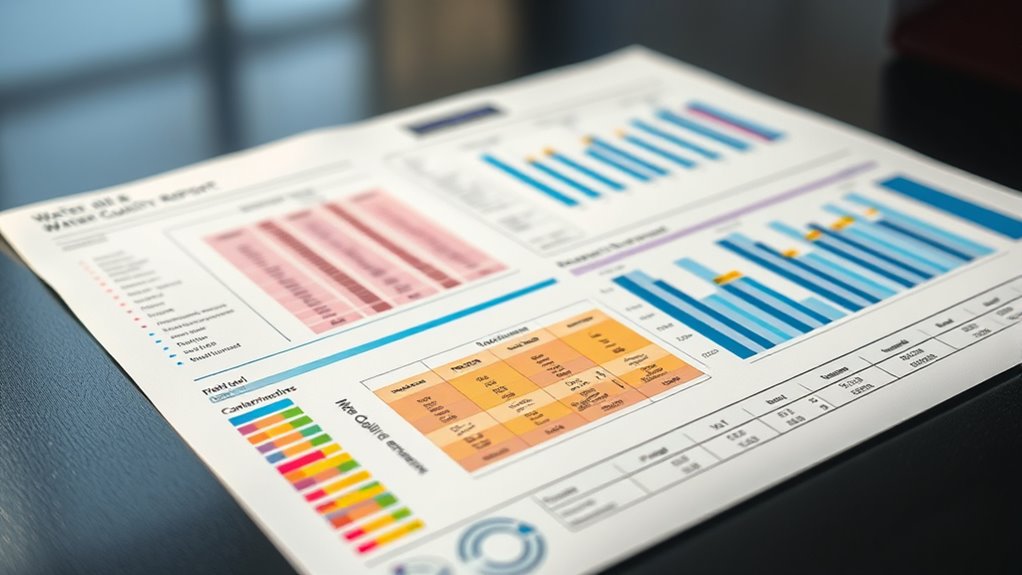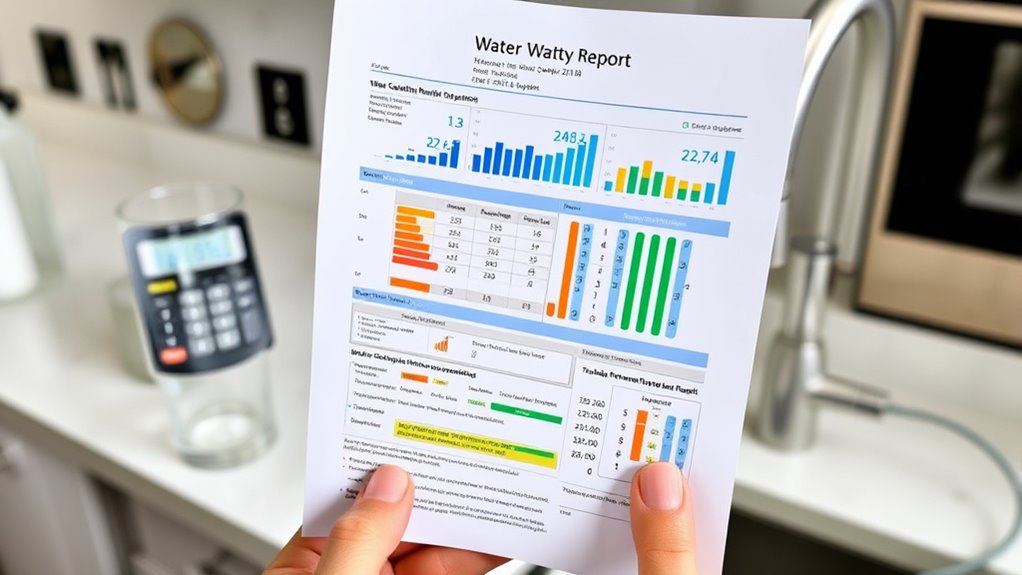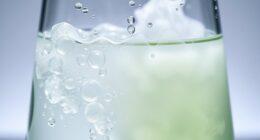To understand a water quality report calculator, focus on how it compares contaminant levels like bacteria, pesticides, and minerals against safety standards. Enter your test results into the tool, which will often use color codes or scores to make analysis simple. This helps you identify potential health risks and whether your water meets safety guidelines. Keep in mind that knowing how to interpret these findings guarantees safer choices—continue to learn how to make the most of these tools.
Key Takeaways
- Input contaminant levels such as pesticides and minerals into the calculator for assessment.
- Compare the results against safety standards to identify potential health risks.
- Use color codes or numerical scores to easily interpret water safety and quality status.
- Focus on key contaminants like bacteria, heavy metals, and pH to determine treatment needs.
- Regularly review updates and standards to ensure accurate analysis and compliance.
Understanding the Basics of Water Quality Reports

Understanding the basics of water quality reports is essential because they provide vital information about the safety and cleanliness of your drinking water. When reviewing these reports, you’ll notice details from water sampling that help identify potential issues. Water sampling involves collecting water samples at different times and locations to check for contaminants. Identifying contaminant sources, such as natural deposits, industrial discharge, or aging infrastructure, is key to understanding what may be affecting your water. These reports highlight which substances are present, their levels, and whether they exceed safety standards. Recognizing the significance of water sampling and contaminant sources allows you to better interpret the data, ensuring you stay informed about what’s in your water and whether it’s safe to drink. Additionally, understanding contaminant levels can help you take appropriate actions if necessary.
Key Components Found in Water Quality Data

Water quality data includes several key components that reveal the safety of your drinking water. You’ll want to pay attention to pesticide residues, which indicate the presence of chemicals from agricultural runoff or contamination. Elevated pesticide levels can pose health risks, so knowing these details helps you assess safety. Another important component is mineral content, which includes minerals like calcium, magnesium, and sodium. These minerals affect taste, health, and water hardness. Monitoring mineral levels ensures your water isn’t too harsh or corrosive. Other components may include bacteria, metals like lead or arsenic, and pH levels. Together, these elements give a thorough picture of your water’s quality, helping you determine if it’s safe to drink or if treatment is needed. Water chemistry analysis provides additional insights into the overall health of your water supply.
How to Use a Water Quality Report Calculator

Have you ever wondered how to quickly interpret your water quality data? Using a water quality report calculator makes it simple. First, input the measured levels of contaminant parameters, including pesticide residues and mineral content. The calculator will compare these values against safety standards to give you a clear understanding of water safety. Pay attention to the pesticide residues—high levels can indicate potential health risks—while mineral content impacts taste and health benefits. The calculator often provides a color-coded or numerical score, helping you assess whether your water meets safety guidelines. Once you’ve entered your data, review the results carefully. This tool streamlines complex data into an easy-to-understand format, empowering you to make informed decisions about your water quality. Understanding cookie categories and their purposes can also help you navigate online tools more effectively.
Interpreting Contaminant Levels and Safety Standards

Once you’ve entered your water quality data into the calculator, the next step is to interpret the contaminant levels relative to safety standards. Check the pH balance to see if it falls within the safe range of 6.5 to 8.5; deviations can affect taste and corrosiveness. Mineral content, such as calcium or magnesium, should also be evaluated—excessive levels may indicate hard water, which can cause scaling. The calculator might indicate if contaminant levels are above or below recommended limits, helping you understand potential health risks. Keep in mind that some minerals contribute to water’s safety, while others may signal contamination. Understanding how your test results compare to safety standards helps you determine whether your water needs treatment or if it’s safe to use, especially considering contaminant tracking features that can identify specific pollutants.
Comparing Your Results to Regulatory Limits

You need to compare your test results with regulatory standards to understand safety. These standards specify the maximum allowed contaminant levels, so it’s crucial to see how your measurements stack up. Interpreting safety margins helps you determine if your water meets health guidelines or if action is needed. Understanding water quality standards can further assist in assessing whether your results are within safe limits.
Regulatory Standards Overview
Understanding how your water test results compare to regulatory standards is essential for ensuring safety and compliance. Regulatory standards are established limits set by authorities to protect water safety and public health. These standards specify maximum allowable levels for contaminants like lead, bacteria, and chemicals. Knowing these limits helps you assess whether your water quality is within safe ranges or if action is needed. When reviewing your results, compare detected levels to the regulatory standards provided in your water quality report. If your measurements exceed these limits, it indicates potential risks and the need for remediation or further testing. Staying informed about regulatory standards empowers you to make safe choices and advocate for water safety in your community. Additionally, understanding how water quality testing is conducted can help you interpret the results more accurately.
Allowed vs. Detected Levels
Comparing your detected contaminant levels to regulatory limits is crucial for evaluating your water quality. When checking pH balance, guarantee your results fall within the acceptable range, typically around 6.5 to 8.5, to avoid corrosiveness or scale buildup. Monitoring mineral content, such as calcium or magnesium, helps confirm if levels stay below safety thresholds, preventing taste issues or health concerns. If your detected levels exceed the allowed limits, it indicates potential health risks or water system issues. Conversely, levels well within the limits suggest your water meets safety standards. Always compare your results directly against regulatory limits listed on the report, paying close attention to pH and mineral content, which considerably influence overall water safety and quality. Incorporating AI-powered analysis can further assist in interpreting complex water quality data for more accurate assessments.
Interpreting Safety Margins
Interpreting safety margins involves examining how your detected chemical contaminants relate to regulatory limits. If your levels are well below the maximum allowed, your water is safer and offers a larger safety margin. Conversely, if they’re close to or above limits, water safety could be compromised. Understanding these margins helps you gauge potential risks and determine if further action is needed. Here’s a visual guide:
| Contaminant Level | Regulatory Limit | Safety Margin | Interpretation |
|---|---|---|---|
| Well below limit | Allowed limit | Large safety margin | Water is safe; minimal risk. |
| Near limit | Allowed limit | Small safety margin | Caution advised; monitor levels. |
| Above limit | Allowed limit | Negative margin (unsafe) | Water unsafe; seek treatment. |
| At limit | Allowed limit | Zero margin | Risk of water safety issues. |
Being aware of regulatory limits allows you to better interpret water safety and take appropriate measures when necessary.
Identifying Common Water Quality Concerns

You should know which contaminants to watch for in your water, like bacteria, nitrates, or heavy metals. Recognizing these common concerns helps you understand potential health risks. Staying informed allows you to take steps to protect yourself and your family. For example, understanding water quality benefits can motivate you to take proactive measures to ensure safe drinking water.
Contaminants to Watch
Understanding common water contaminants is essential for ensuring safe drinking water. You should watch for pesticide detection, which can indicate agricultural runoff and pose health risks if present in high levels. Heavy metal contamination is another concern, often stemming from industrial sources or corroded pipes, and can lead to serious health issues over time. These contaminants are typically listed on water quality reports, and their presence signals the need for further testing or treatment. Being aware of these common concerns helps you identify potential risks early. Regularly reviewing your water report for pesticides and heavy metals allows you to take proactive steps. Additionally, understanding projector image quality factors like contrast ratio and color accuracy can help you assess the overall health of your water system, ensuring better safety measures. Protecting your health starts with understanding what contaminants to watch for and staying informed about your water’s quality.
Health Impact Awareness
Being aware of common water quality concerns is essential for protecting your health. Contaminants like bacteria, nitrates, and heavy metals can pose serious risks, especially to vulnerable groups such as children. Waterborne illnesses, caused by pathogens like E. coli or Giardia, can lead to diarrhea, dehydration, and other health issues. Recognizing these risks helps you understand why regular testing and reviewing water quality reports matter. If you notice elevated levels of certain contaminants, it’s vital to take action to reduce exposure, particularly for pediatric health, since children are more susceptible to waterborne illnesses. Staying informed empowers you to make safer choices, whether that’s installing filters or contacting your water provider for clarification. Protecting your family starts with understanding the common concerns in your water supply.
Using the Calculator to Assess Risk Levels

Using the calculator to assess risk levels allows you to quickly determine potential health concerns based on your water quality data. Once you input your test results, the calculator highlights contaminants that exceed safe limits, helping you identify if your water needs treatment. If risks are high, you might consider installing home filtration systems to reduce harmful substances effectively. Alternatively, opting for bottled water can be a practical short-term solution for ensuring safety. The calculator simplifies complex data, making it easier to decide whether your water poses health risks and what action to take. By understanding these risk levels, you can make informed choices about protecting your health and maintaining safe drinking water at home.
Practical Tips for Making Informed Water Choices

To make smart water choices, start by understanding local water standards and what they mean for your health. Learn to identify contaminants in your water reports so you can recognize potential issues. Finally, compare different treatment options to find the most effective solution for your needs.
Understand Water Standards
Understanding water standards is essential for making informed choices about the water you drink. These standards set safe levels for key factors like pH balance and mineral content, ensuring water is healthy and palatable. For example, water with proper pH is neither too acidic nor too alkaline, which affects taste and pipe corrosion. Mineral content influences flavor and health benefits. Visualize this table:
| Water Standard Aspect | What It Means |
|---|---|
| pH Balance | Maintains neutrality for safety |
| Mineral Content | Ensures balanced nutrients |
| Contaminant Limits | Prevents harmful substances |
| Microorganisms | Keeps water free of bacteria |
| Chemical Levels | Controls toxins and pollutants |
Identify Contaminants Clearly
Identifying contaminants in your water is essential for ensuring its safety and quality. Pesticide contamination can pose health risks, so check the report for any presence of pesticides or related chemicals. Look for specific details on the types and levels of pesticides detected. Additionally, understanding the mineral content helps you evaluate water’s overall safety and taste. Excess minerals like calcium or magnesium can affect water quality, while low mineral levels may indicate treatment issues. Clear identification of these contaminants allows you to make informed decisions about your water source. Focus on the details in the report that specify the concentrations of harmful substances and minerals. Recognizing these signs helps you determine if your water meets safety standards or if further treatment is necessary.
Compare Treatment Options
When comparing water treatment options, it’s important to contemplate the specific contaminants present and how effectively each method addresses them. Different filtration methods target various pollutants, so understanding your water report helps you choose the right solution. For example, activated carbon filters excel at removing chlorine and organic compounds, while reverse osmosis systems tackle heavy metals and nitrates. Consider your water quality results carefully to match treatment options with your needs. Some filtration methods are simple and affordable, while others require more maintenance or upfront investment. By evaluating the contaminants you need to remove and the strengths of each water treatment method, you can make an informed choice that guarantees safe, clean water for your household.
When to Seek Professional Water Testing

You should consider professional water testing if you notice unusual smells, tastes, or discoloration in your water, as these can be signs of contamination. In such cases, a thorough contamination analysis is essential to identify the pollutants causing these issues. Water testing performed by professionals provides accurate results that home tests might miss, especially for certain contaminants like heavy metals or bacteria. If your water has a strange odor or murky appearance, don’t wait—seek expert testing promptly. Professional testing also helps determine if your water meets safety standards and guides necessary treatment steps. Remember, early detection of contamination protects your health and ensures your water remains safe to use. When in doubt, professional water testing is your best move.
Staying Updated on Water Quality Regulations

Staying informed about water quality regulations is essential to guarantee your water supply remains safe and compliant with the latest standards. Regular updates on regulations help you understand changes in water purification requirements and ensure your system meets all safety criteria. Keep track of local and federal guidelines to prevent health risks and avoid violations. Proper plumbing maintenance also plays a crucial role in maintaining water quality, preventing issues like corrosion or contamination. By staying current, you can make informed decisions about upgrades or treatment methods needed to meet regulatory standards. Subscribing to official notices, industry newsletters, or consulting with water quality experts ensures you’re always in the know. This proactive approach safeguards your health and keeps your water system functioning efficiently.
Frequently Asked Questions
How Often Should I Review My Water Quality Report?
You should review your water quality report at least once a year to stay informed about contaminant levels and any changes in water testing results. Regularly checking the report helps you identify potential issues early and guarantees your water remains safe. If you notice any significant changes or concerns, perform additional testing and consult a professional for guidance. Staying proactive keeps you and your family protected from water quality problems.
Can Water Quality Reports Predict Long-Term Health Effects?
You might think water quality reports can predict long-term health effects, but don’t rely on their predictive accuracy. While they reveal current contaminants and potential health implications, they can’t forecast all future issues. Water reports help you understand immediate risks, but the subtle, long-term health effects often remain uncertain. So, stay informed, take precautions, and remember—these reports are more about current safety than crystal balls.
What Affordable Methods Exist to Improve Water Quality at Home?
You can improve your water quality at home affordably by installing a home filtration system, such as activated carbon filters or reverse osmosis units, which effectively remove contaminants. Additionally, you should perform DIY testing with water test kits to monitor your water’s quality regularly. These simple methods help you guarantee safer drinking water, save money, and maintain control over your water’s purity without costly professional services.
Are There Geographic Differences in Water Contamination Risks?
Yes, you’ll notice geographic disparities and regional contamination risks vary widely. In some areas, industrial pollution or agricultural runoff heighten contamination, while others remain safer. Your location affects water quality because regional contamination sources differ, influencing the presence of pollutants like lead, nitrates, or bacteria. Stay informed by checking local water reports and testing your water regularly, especially if you suspect regional contamination issues.
How Do Seasonal Changes Impact Water Quality Readings?
Seasonal fluctuations considerably impact water quality readings by altering contaminant trends throughout the year. During spring, runoff can increase levels of pollutants like nitrates and bacteria, while winter may reduce certain contaminants due to lower temperatures. You’ll notice these changes in water test results, so it’s essential to take seasonal variations into account when evaluating water safety. These fluctuations help identify patterns and improve your understanding of ongoing contaminant trends.
Conclusion
Now that you know how to read a water quality report and use the calculator, you’re better equipped to make informed decisions about your water. Remember, even the most seasoned sailors consult their charts and tools before setting sail. Stay vigilant, keep up with regulations, and don’t hesitate to seek professional testing if something seems off. With these skills, you’re ready to navigate your water safety with confidence, no matter what the future holds.









